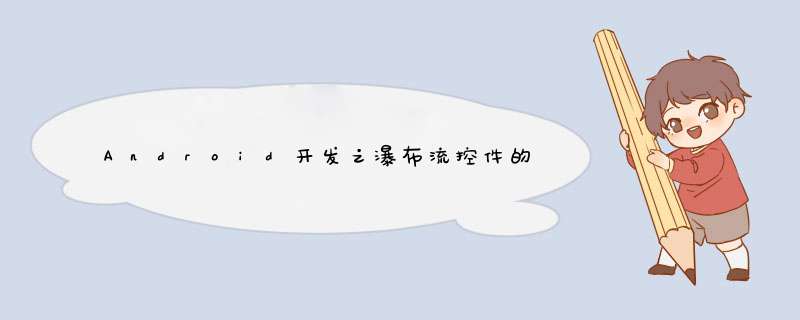
本文实例讲述了AndroID开发之瀑布流控件的实现与使用方法。分享给大家供大家参考,具体如下:
public class FlowLayout extends VIEwGroup { /**行里子vIEw之间的行距离*/ public int mHorizontolSpace = Util.getDimen(R.dimen.top_padding); /**行里子vIEw之间的垂直距离*/ public int mVerticalSpace = Util.getDimen(R.dimen.top_padding); /**创建行的集合*/ private List<line> mlines = new ArrayList<line>(); /**当前行*/ private line mCurrentline; /**当前行使用的宽度*/ private int mCurrentUseWIDth = 0; /**父容器的宽高*/ private int parentWIDthSize; private int parentHeightSize; public FlowLayout(Context context,AttributeSet attrs,int defStyleAttr) { super(context,attrs,defStyleAttr); } public FlowLayout(Context context,AttributeSet attrs) { super(context,attrs); } public FlowLayout(Context context) { super(context); } @OverrIDe protected voID onMeasure(int wIDthMeasureSpec,int heightmeasureSpec) { //0.先清空行集合里的数据 clear(); //1.得到父vIEwGroup的模式与大小 int parentWIDthMode = MeasureSpec.getMode(wIDthMeasureSpec);// parentWIDthSize = MeasureSpec.getSize(wIDthMeasureSpec) - getpaddingleft() - getpaddingRight(); int parentHeightmode = MeasureSpec.getMode(heightmeasureSpec); parentHeightSize = MeasureSpec.getSize(heightmeasureSpec) - getpaddingBottom() - getpaddingtop(); /* 每个子vIEw都是包裹内容 * layout.addVIEw(mTextVIEw,new linearLayout.LayoutParams(LayoutParams.WRAP_CONTENT * 得到每个孩子的测量规则 */ //2.得到每个孩子的模式 int chilDWIDthMode = parentWIDthMode == MeasureSpec.EXACTLY ? MeasureSpec.EXACTLY : parentWIDthMode; int childHeightmode = parentHeightmode == MeasureSpec.EXACTLY ? MeasureSpec.EXACTLY : parentHeightmode; //3.根据模式得到子控件的大小 int chilDWIDthMeasureSpec = MeasureSpec.makeMeasureSpec(chilDWIDthMode,parentWIDthSize); int childHeightmeasureSpec = MeasureSpec.makeMeasureSpec(childHeightmode,parentHeightSize); //得到子vIEw的个数 int count = getChildCount(); //创建新的行 mCurrentline = new line(); for (int i = 0; i < count; i++) { VIEw childVIEw = getChildAt(i); //4.测量每个孩子 childVIEw.measure(chilDWIDthMeasureSpec,childHeightmeasureSpec); //5.得到测量后的孩子的宽高 int childMeasureWIDth = MeasureSpec.getSize(chilDWIDthMeasureSpec); //int childMeasureHeight = MeasureSpec.getSize(childHeightmeasureSpec); //6.得到此行使用的宽度 mCurrentUseWIDth += childMeasureWIDth; //7.判断此行的宽度是否大于父控件的宽度,如果大于则换行 if (mCurrentUseWIDth > parentWIDthSize) { //8.如果当前的子vIEw的宽度大于父容器的宽度,强行把这个vIEw添加的集合里 if (mCurrentline.getChildCount()<1) { mlines.add(mCurrentline); } //9.换行 newline(); }else { //8.把当前子vIEw添加到行里 mCurrentline.addChild(childVIEw); //9.添加间隔 mCurrentUseWIDth += mHorizontolSpace; if (mCurrentUseWIDth > parentWIDthSize) { //10.换行 newline(); } } } //11.如果集合里没有添加当前行,则把当前添加到集合 if (!mlines.contains(mCurrentline)) { mlines.add(mCurrentline); } //12.设置富容器的总宽高 int parentWIDth = parentWIDthSize + getpaddingleft() + getpaddingRight(); int parentHeight = (mlines.size()-1) * mVerticalSpace + getpaddingBottom() + getpaddingtop(); for(line line : mlines){ //得到所以line的高度 parentHeight += line.getHeight(); } //13.resolveSize表示哪个高度合适,就用哪个 setMeasuredDimension(parentWIDth,resolveSize(parentHeightSize,parentHeight)); /*setMeasuredDimension(getDefaultSize(getSuggestedMinimumWIDth(),wIDthMeasureSpec),getDefaultSize(getSuggestedMinimumHeight(),heightmeasureSpec));*/ } /** * 换行 */ private voID newline() { //a.先把当前的行添加到集合 mlines.add(mCurrentline); //b.创建新的一行 mCurrentline = new line(); //c.新行里的使用的行必须设置为0 mCurrentUseWIDth = 0; } public voID clear() { mlines.clear(); mCurrentline = null; mCurrentUseWIDth = 0; } @OverrIDe protected voID onLayout(boolean changed,int l,int t,int r,int b) { //15.得到每个line孩子的左上角的坐标 int left = l + getpaddingleft(); int top = t + getpaddingtop(); //现在容器里只有line是子孩子 for (int i = 0; i < mlines.size(); i++) { line line = mlines.get(i); //16.把分配位置给line去处理 line.layout(left,top); //17.设置第一行后的其它行的top数值 top += line.getHeight() + mVerticalSpace; } } /** * 行类,用来封装一行的vIEw */ private class line{ /**当前行的宽度*/ private int mWIDth = 0; /**当前行的高度*/ private int mHeight = 0; /**每个孩子得到的剩余空间*/ int mChildPdding = 0; private List<VIEw> children = new ArrayList<VIEw>(); public voID addChild(VIEw childVIEw) { children.add(childVIEw); //取得之vIEw里最高的高度 if (childVIEw.getMeasuredHeight() > mHeight) { mHeight = childVIEw.getMeasuredHeight(); } //18.得到行宽度 mWIDth += childVIEw.getMeasureDWIDth(); } /** * 定位每个line在富容器里的额位置 * @param left * @param top */ public voID layout(int left,int top) { //18.得到行宽度 mWIDth += mHorizontolSpace * (children.size() -1); //19.得到剩余的宽度大小 //int padding = getMeasureDWIDth() - mWIDth; int padding = parentWIDthSize - mWIDth; if (padding > 0) { mChildPdding = padding / children.size(); } // getWIDth()vIEw显示的时候大小,如果vIEw没显示,这个值就为0,步包括隐藏的部分,getMeasureDWIDth()控件实际大小,包括隐藏的部分 //一般来说 getMeasureDWIDth() > getWIDth(); for (int i = 0; i < children.size(); i++) { VIEw child = children.get(i); //第一种:有间隔的flow int bottom = child.getMeasuredHeight() + top; //20.把剩余的空间分配给每个vIEw int right = child.getMeasureDWIDth() + left + mChildPdding; //第二种:无间隔的flow// int bottom = getMeasuredHeight() + top;// int right = getMeasureDWIDth() + left; //第一个child的位置 child.layout(left,top,right,bottom); //第二个及后面child的right right += child.getMeasureDWIDth() + mHorizontolSpace + mChildPdding; } } /** * 得到子vIEw的大小 * @return */ public int getChildCount() { if (children != null) { return children.size(); } return 0; } public int getHeight() { return mHeight; } }}使用方法:
public class topFragment extends Fragment{ @OverrIDe public VIEw onCreateVIEw(LayoutInflater inflater,VIEwGroup container,Bundle savedInstanceState) { ScrollVIEw scrollVIEw = new ScrollVIEw(getActivity()); FlowLayout layout = new FlowLayout(getActivity()); layout.setBackgroundDrawable(Util.getDrawable(R.drawable.List_item_bg)); int padding = Util.getDimen(R.dimen.top_padding); layout.setpadding(padding,padding,padding); GradIEntDrawable pressDrawable = Drawableutil.createDrawable(0xffcecece); for (int i = 0; i < mDatas.size(); i++) { mTextVIEw = new TextVIEw(getActivity()); mTextVIEw.setText(mDatas.get(i)); GradIEntDrawable randomDrawable = Drawableutil.createrandomDrawable(); StateListDrawable stateListDrawable = Drawableutil.createStateDrawable(pressDrawable,randomDrawable); mTextVIEw.setBackgroundDrawable(stateListDrawable); mTextVIEw.setText@R_419_6004@(@R_419_6004@.WHITE); int left = Util.px2dip(7); int top = Util.px2dip(4); int right = Util.px2dip(7); int bottom = Util.px2dip(4); mTextVIEw.setpadding(left,bottom); mTextVIEw.setTag(mDatas.get(i)); mTextVIEw.setonClickListener(this); layout.addVIEw(mTextVIEw,new linearLayout.LayoutParams(LayoutParams.WRAP_CONTENT,- 2)); } scrollVIEw.addVIEw(layout); } return scrollVIEw;}工具类:
public class Drawableutil { /** * 创建随机背景的drawable * @return */ public static GradIEntDrawable createrandomDrawable(){ GradIEntDrawable drawable = new GradIEntDrawable(); drawable.setCornerRadius(Util.px2dip(5)); Random random = new Random(); int red = random.nextInt(200) + 20; int green = random.nextInt(200) + 20; int blue = random.nextInt(200) + 20; int @R_419_6004@ = @R_419_6004@.rgb(red,green,blue); drawable.set@R_419_6004@(@R_419_6004@); return drawable; } /** * 创建带有背景的drawable * @return */ public static GradIEntDrawable createDrawable(int @R_419_6004@){ GradIEntDrawable drawable = new GradIEntDrawable(); drawable.setCornerRadius(Util.px2dip(5)); drawable.set@R_419_6004@(@R_419_6004@); return drawable; } /** * 状态选择器 * @param press * @param normal * @return */ public static StateListDrawable createStateDrawable(Drawable press,Drawable normal){ StateListDrawable drawable = new StateListDrawable(); //按下 drawable.addState(new int[]{androID.R.attr.state_pressed},press); //正常 drawable.addState(new int[]{},normal); return drawable; }}更多关于AndroID相关内容感兴趣的读者可查看本站专题:《Android窗口相关 *** 作技巧总结》、《Android开发入门与进阶教程》、《Android调试技巧与常见问题解决方法汇总》、《Android基本组件用法总结》、《Android视图View技巧总结》、《Android布局layout技巧总结》及《Android控件用法总结》
希望本文所述对大家AndroID程序设计有所帮助。
总结以上是内存溢出为你收集整理的Android开发之瀑布流控件的实现与使用方法示例全部内容,希望文章能够帮你解决Android开发之瀑布流控件的实现与使用方法示例所遇到的程序开发问题。
如果觉得内存溢出网站内容还不错,欢迎将内存溢出网站推荐给程序员好友。
欢迎分享,转载请注明来源:内存溢出

 微信扫一扫
微信扫一扫
 支付宝扫一扫
支付宝扫一扫
评论列表(0条)